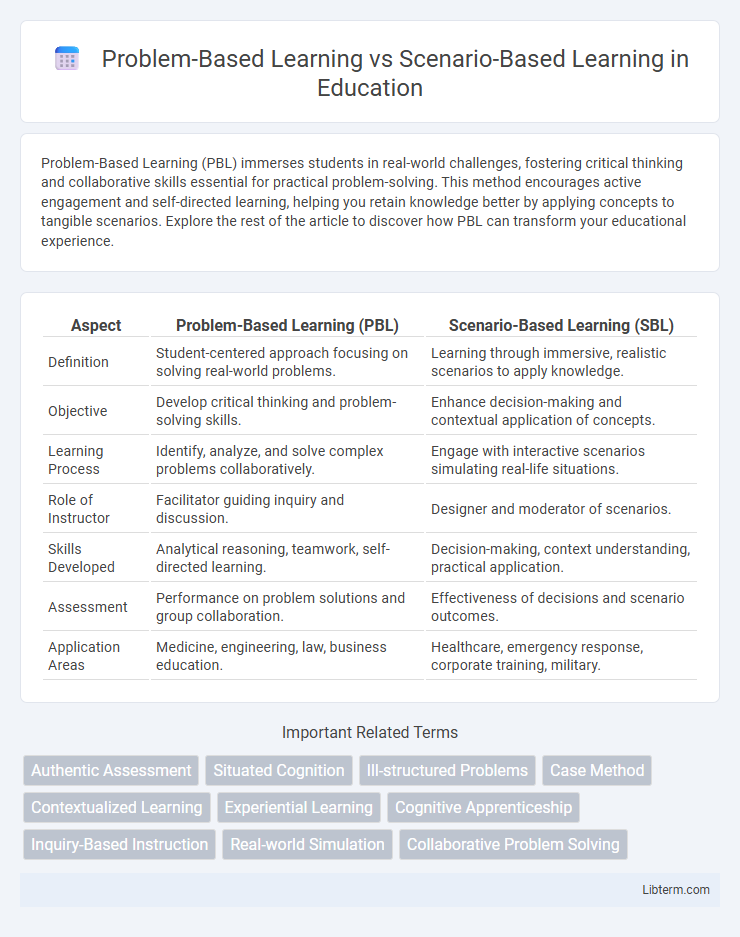Problem-Based Learning (PBL) immerses students in real-world challenges, fostering critical thinking and collaborative skills essential for practical problem-solving. This method encourages active engagement and self-directed learning, helping you retain knowledge better by applying concepts to tangible scenarios. Explore the rest of the article to discover how PBL can transform your educational experience.
Table of Comparison
| Aspect | Problem-Based Learning (PBL) | Scenario-Based Learning (SBL) |
|---|---|---|
| Definition | Student-centered approach focusing on solving real-world problems. | Learning through immersive, realistic scenarios to apply knowledge. |
| Objective | Develop critical thinking and problem-solving skills. | Enhance decision-making and contextual application of concepts. |
| Learning Process | Identify, analyze, and solve complex problems collaboratively. | Engage with interactive scenarios simulating real-life situations. |
| Role of Instructor | Facilitator guiding inquiry and discussion. | Designer and moderator of scenarios. |
| Skills Developed | Analytical reasoning, teamwork, self-directed learning. | Decision-making, context understanding, practical application. |
| Assessment | Performance on problem solutions and group collaboration. | Effectiveness of decisions and scenario outcomes. |
| Application Areas | Medicine, engineering, law, business education. | Healthcare, emergency response, corporate training, military. |
Introduction to Problem-Based Learning (PBL)
Problem-Based Learning (PBL) centers on students actively solving real-world problems, promoting critical thinking and self-directed learning through collaborative inquiry. It contrasts with Scenario-Based Learning by emphasizing open-ended problems without predefined solutions, encouraging deeper exploration and knowledge construction. PBL's structured approach enhances problem-solving skills essential for fields like healthcare and engineering.
Overview of Scenario-Based Learning (SBL)
Scenario-Based Learning (SBL) immerses learners in realistic, context-rich situations that mimic real-world challenges to enhance critical thinking and decision-making skills. By presenting complex scenarios requiring active problem-solving, SBL fosters deeper understanding through experiential engagement and reflection. This method is widely applied in healthcare, business, and emergency response training to simulate authentic environments and improve practical competence.
Core Principles of PBL
Problem-Based Learning (PBL) centers on student-driven inquiry where learners collaboratively identify and solve complex, real-world problems, promoting critical thinking and self-directed learning. Core principles include authentic problem scenarios, facilitation rather than direct instruction, and iterative reflection to deepen understanding. This approach emphasizes knowledge acquisition through active problem-solving within a collaborative environment, distinguishing it from Scenario-Based Learning, which often focuses more on decision-making within pre-defined situations.
Core Principles of SBL
Scenario-Based Learning (SBL) centers on immersive, real-world situations that require learners to apply knowledge and decision-making skills actively, fostering critical thinking through context-rich challenges. Core principles of SBL include authenticity, where scenarios mimic real-life complexities; learner engagement through interactive storytelling; and immediate feedback that guides reflection and skill refinement. Unlike Problem-Based Learning, which emphasizes self-directed problem solving, SBL integrates narrative elements to enhance motivation and practical application within specific professional or educational contexts.
PBL vs SBL: Key Differences
Problem-Based Learning (PBL) centers on real-world problems that lack clear solutions, encouraging learners to develop critical thinking and self-directed research skills, while Scenario-Based Learning (SBL) uses specific situational contexts designed to mimic real-life scenarios for applying knowledge and decision-making practice. PBL is more open-ended and exploratory, fostering deep inquiry and collaborative problem-solving over extended periods, whereas SBL offers structured, often linear scenarios focused on skill application and immediate feedback in controlled environments. The key difference lies in PBL's emphasis on problem exploration and student-driven learning versus SBL's focus on context-driven practice and scenario-specific outcomes.
Advantages of Problem-Based Learning
Problem-Based Learning (PBL) enhances critical thinking and problem-solving skills by engaging students directly with complex, real-world problems, promoting deep understanding and knowledge retention. PBL fosters self-directed learning and collaboration, enabling learners to develop research abilities and teamwork skills essential for professional success. Studies show PBL increases motivation and adaptability, preparing students effectively for diverse challenges in various disciplines.
Benefits of Scenario-Based Learning
Scenario-Based Learning enhances critical thinking by immersing learners in realistic contexts that simulate actual challenges, promoting practical decision-making skills. It fosters deeper engagement and retention through interactive storytelling, allowing learners to explore consequences of their choices in a safe environment. This method supports adaptive learning by catering to diverse learning styles and encouraging collaborative problem-solving among participants.
Challenges in Implementing PBL and SBL
Problem-Based Learning (PBL) faces challenges such as the need for skilled facilitators to guide complex problem-solving without direct instruction, and ensuring students possess sufficient foundational knowledge to engage effectively. Scenario-Based Learning (SBL) struggles with the creation of realistic and contextually relevant scenarios that accurately simulate real-world situations while maintaining learner engagement and assessing competence. Both approaches demand significant time and resources for development and implementation, impacting scalability and consistency across diverse educational settings.
Real-World Applications: PBL and SBL in Education
Problem-Based Learning (PBL) engages students in solving authentic, complex problems, fostering critical thinking and collaborative skills crucial for real-world applications in education. Scenario-Based Learning (SBL) immerses learners in realistic scenarios that simulate professional contexts, enhancing decision-making and practical understanding. Both approaches effectively prepare students by connecting academic knowledge with applicable skills in diverse real-life situations.
Choosing the Right Approach: PBL or SBL?
Choosing the right approach between Problem-Based Learning (PBL) and Scenario-Based Learning (SBL) depends on educational goals and learner needs. PBL emphasizes open-ended problems that enhance critical thinking and self-directed learning, making it ideal for developing problem-solving skills in complex, real-world situations. SBL uses structured, narrative-driven scenarios to simulate specific contexts, which benefits learners requiring practical application and decision-making in controlled environments.
Problem-Based Learning Infographic

 libterm.com
libterm.com